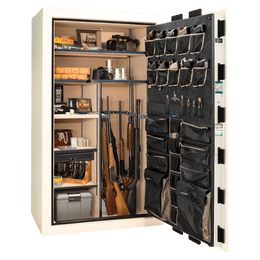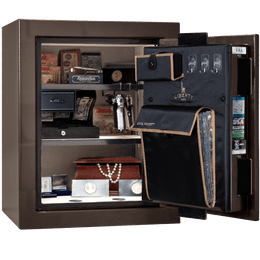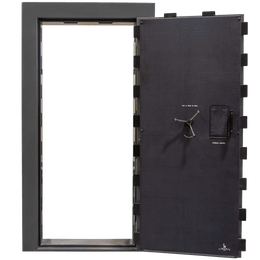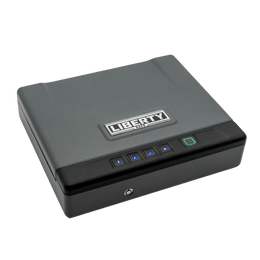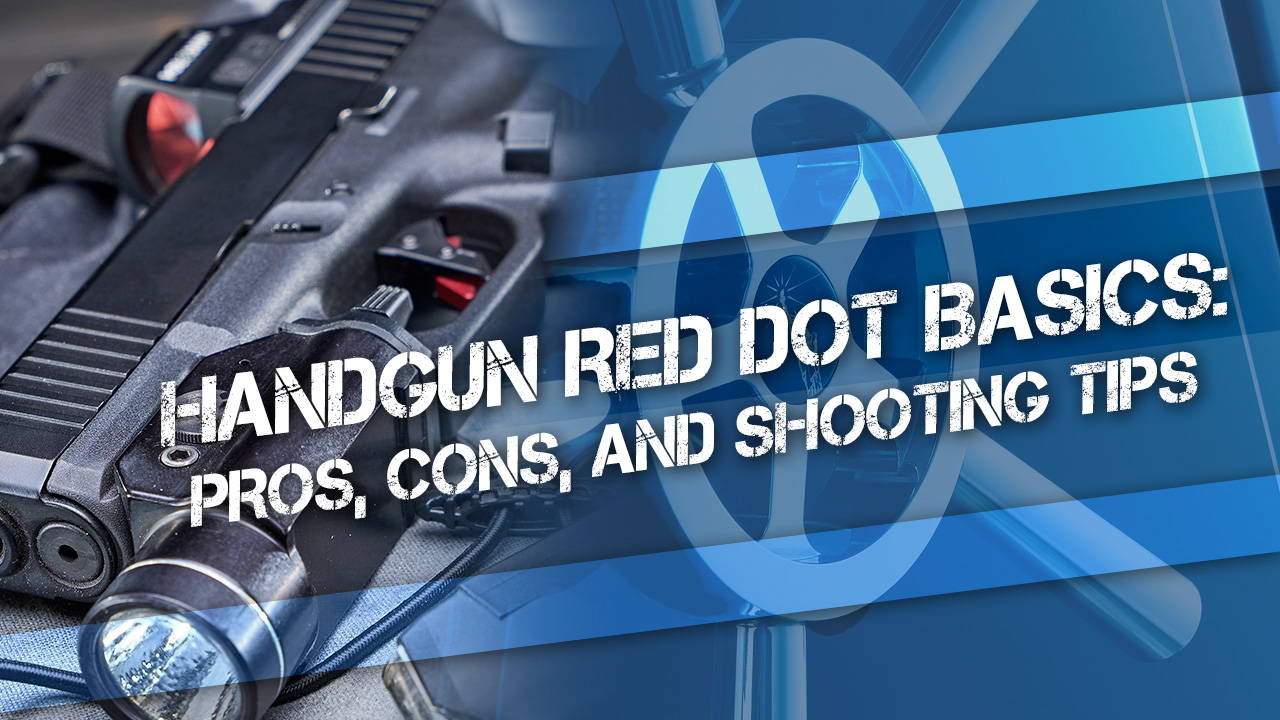If you’ve been paying attention to the defensive or competition handgun market over the past 10 years, you’re likely aware of the growing trend toward slide-mounted mini red dot sights (MRDS) in addition to (or in place of) standard iron sights. Most handgun manufacturers now offer at least one model with integrated mounting provisions for a red dot sight and makers that don’t are feeling a lot of consumer pressure to add them.
The reasons red dots are becoming more commonplace on handguns (and we feel this trend will continue until it’s “the norm”) are largely the same as the reasons red dots have become ubiquitous on combat and practical competition rifles: firearms mounted with red dots are easier to use, simpler to learn, and faster to shoot.
In this article, we’ll elaborate on the key reasons why MRDS on handguns are taking over the market. We’ll also cover the pros and cons of handgun red dots, in addition to the basics of shooting them well.
Red dot sights on handguns have been used in competition for decades
Aimpoint was the first big name to popularize the use of its simple, rugged red dot “scopes” on rifles and handguns, as far back as the mid-to-late 1970s. In the 80s, IPSC handgun shooters began to build custom scope mounts on their revolvers and 1911s to allow the installation of red dot scopes (and they looked very similar to traditional scopes, with a tube-shaped profile).
This tube-type red dot scope also became very popular in Bullseye handgun competition, and red dots of all types remain legal in the sport to this day.
However, the “micro” or “mini” red dot sights of today didn’t start appearing until around 2005, and their use on handguns definitely took a leap forward in 2009 with Trijicon’s introduction of its excellent RMR (Ruggedized Miniature Reflex) optical sight, which remains a top choice for duty, defensive, and rough competition use.
Key advantages of a handgun red dot optic/MRDS vs. traditional iron sights
Single focal plane
The human eye can only focus on one thing at a time, in one focal plane. When shooting a handgun with traditional iron sights, most people are told to focus hard on the front sight, while the rear sight and the target will necessarily be slightly blurry. However, studies show that our biology prioritizes a “threat focus” when under stress, so you are likely to focus hard on an attacker (often specifically on the attacker’s weapon in a defensive situation) or the target (in a stressful, timed competition) rather than on the front sight, unless you’ve practiced long and hard to do otherwise.
One primary advantage of the MRDS optic is that there is only one focal plane required: you simply focus on the target and if you align your handgun properly, the red dot will appear “on the target” where you are aiming. There’s no confusing 3-focal-plane nonsense or shifting your focus from the target to the front sight and back.
Wider, less restricted field of view
Traditional iron sights, using a common “center hold” where the bullet impacts the target just above the front sight, require you to cover the bottom half of the target with the sights to achieve proper sight picture and sight alignment. You’re only seeing the top half of the target, with your sights and firearm obscuring everything below.
A red dot, even the relatively small window of a MRDS on a handgun held at arm’s length, will still allow a much greater view of the target, the point of aim, and the area below it, compared to iron sights. Depending on the distance, you can often see the entire target through the window as well as much of the surrounding space.
Many shooters say they don’t even notice the housing of the MRDS, and just see the target with the dot hovering “in front” of it when they’re in the zone.
More accurate
Most shooters find they can shoot more accurately with a red dot than with iron sights, particularly at distance and when speed is an issue. With the dot, you can easily “holdover” for longer shots, while still seeing the entire target in the window. Your eye will also automatically center the dot on a round bullseye target, which is easier to see clearly at distance when using a “target focus,” as discussed above.
Faster transitions, faster shooting
There’s a reason “open guns” at handgun competitions nearly always include an optical sight. The speed and accuracy advantages are undeniable. Even skeptics of the “newfangled” MRDS will become converts if they practice with it and shoot back-to-back strings using a shot timer. Transitioning from one target to another is simply faster and easier if you don’t have to worry about aligning your front sight, your rear sight, and your target. The numbers don’t lie… where speed is paramount, the red dot is king.
Better for “old eyes”
Many older shooters who have trouble getting an effective sight picture with iron sights can find renewed handgun prowess by adding an MRDS. Even if the actual “dot” or reticle isn’t super crisp for these shooters, they can still easily align the dot on the target and make effective hits.
Disadvantages of a handgun red dot optic compared to iron sights
Durability issues
Although the most recent generations of the MRDS, at least the top quality (and expensive) ones, can absorb quite a lot of abuse, they are still complicated electronic devices that include glass and solder and wires and batteries. So they are inherently more fragile than simple, low-profile sights made of steel.
Also, some MRDS optics’ mounting screws and/or plates (particularly on Glock’s MOS-equipped guns) have been known to break due to the forces involved, and people have been beaned in the forehead by flying red dots. So be sure to vet your combination of handgun and MRDS thoroughly and carefully before any serious use.
Expense
Prices have come down and entry-level MRDS are now available for well under $100 (though we wouldn’t recommend them). However, a good one will cost you from around $300 up to $700. In some cases, this is more than the price of the pistol you mount it on. Though the practical advantages of the red dot are undeniable, many people find the expense to be a deal-breaker.
Reticle washout/flare
Most red dot sights either automatically adjust to ambient lighting conditions via an electronic sensor or are manually set to a specific brightness by the user. In both cases, the reticle/dot can be washed out or become nearly invisible when shooting from a dark space into a light/outdoor space, for example, or when shooting inside a dark room but with a tactical light illuminating the target.
This can be mitigated somewhat by turning up the dot’s brightness higher than you would typically want it, but it’s still a potential issue. In addition, when you crank up the brightness of the dot too high, there is almost always some “bloom” or flare around the reticle and it can appear less crisp and larger than it needs to be for utmost accuracy.
Fogging, rain, or debris can obscure open-LED emitters and/or the sight window
The open-type design of many mini red dot sights (including the Trijicon RMR) can allow rain or condensation to obscure the LED emitter (the “red dot” that’s reflected on the optic’s window), and a drop of water in the right spot can also cause the dot to “fracture” and appear as several dots in the reflecting window.
While this condition is relatively rare, it certainly is a consideration and within the realm of possibility, particularly for police officers who carry their duty handguns in an external belt holster in cold weather, and then enter a warm space, or shooters who use their handguns in the rain.
Furthermore, if an open-emitter MRDS-equipped handgun is dropped in the dirt, snow, or mud, debris can obscure the emitter and/or the sight window and can be difficult to remove.
There is a very recent trend toward fully enclosed MRDS like the Aimpoint Acro and the Holosun EPS series, and this can eliminate the issues above, but these sights are pretty expensive and are more bulky than traditional open-emitter MRDS types.
Astigmatism and red dots
People with astigmatism or other eyesight issues can sometimes have a hard time getting a sharp sight picture when using a red dot. The dot can appear blurry, or perhaps shaped like a teardrop or question mark, or even two dots. Trying a green, rather than red, reticle can sometimes alleviate this, as can trying a different brand or model of MRDS and seeing which one looks the best to you. The best advice here is try before you buy.
Battery life
Though some MRDS types are available with solar panels to enhance battery life (or with tritium+fiber-optic illumination), the best-looking, best-shooting, and most versatile red dots all run on batteries. The top manufacturers promise battery life between 6 months and 5 years depending on use and brightness settings, but the fact is you’re still going to want to change your battery sooner than recommended, just to be safe.
(We’ve had a battery on a frequently-used Trijicon RMR last for over 3 years, but we don’t recommend putting this to the test, particularly on duty or defensive-use optics.)
At a minimum, we recommend you change your battery every year on New Year’s Day, or your birthday, or other memorable day (and change all the batteries in your home smoke/carbon monoxide detectors, and your Liberty safe’s SecuRam electronic lock at the same time).
The Deltapoint Pro and most of the Holosun red dots have top- or side-mounted battery access, while the RMR must be removed from the slide to replace the battery, which of course requires you to clean and remount the screws with threadlocker, and re-zero your optic after reinstallation. Some find this a hassle, and some feel it’s a small price to pay for unparalleled durability.
Holster/concealment options may be limited
The larger the optical window and the more durable the MRDS housing, the bulkier it will be when mounted on top of your handgun. Some holsters are incompatible with red dot-equipped handguns, and the additional bulk and sharpish edges of some mini red dots can make concealed carry (particularly pocket carry) a chore.
Difficult to learn
Now, we aren’t contradicting ourselves. In the intro above we said that MRDS handguns were “simpler to learn” than iron sights. However, what that means is that for a new shooter, it’s easier to learn to align a red dot on the target than it is to line up the rear sight, front sight, and the target for a proper sight picture.
For someone who has been shooting for years and is accustomed to the “front sight, press” school of handgun shooting, switching to an MRDS-equipped gun can be mildly frustrating at best and infuriating at worst. We’ve known several shooters who simply refused to try to learn to shoot a red dot after one try, because they found it so counterintuitive. But if you dedicate yourself to regular practice, a red-dot-equipped handgun may become your favorite tool.
Counterfeits
It’s an unfortunate fact of our global economy that anything that is in high demand (and is relatively high in price) will inevitably attract counterfeits from China. So if you are shopping for your “Trijicon” MRDS on sites like eBay or Amazon, be very careful to check multiple sources, read reviews, and learn the tell-tale signs of counterfeits before you get burned on a knock-off at a “great price.”
Tips on shooting a red dot optic-equipped handgun well
The main difficulty most shooters have when transitioning to a red-dot-equipped handgun is “finding the dot.” Since the dot and window are completely independent of traditional sight alignment, many shooters find themselves fishing for the dot, or quickly losing the dot after they find it, or after each shot.
The short answer to this problem is “practice, practice, practice.” The more you practice getting a consistent draw, and a consistent presentation of the gun, the more often the red dot will be aligned with your eye at the completion of the draw stroke. It takes lots of slow, perfect repetitions to allow you to gradually increase your draw/presentation speed, and if you practice enough you’ll find that you don’t even have to think about finding that dot; it will simply appear on the target and you can break the shot.
A very firm grip and a lighter-recoiling cartridge (like the 9mm) helps with tracking the dot through recoil and realignment. Many shooters find they can keep the dot in the window through the entire recoil cycle and watch it re-settle on the target, if they develop a proper, firm grip and practice enough.
Consider installing co-witness iron sights
Moving from iron sights to a handgun without them, one equipped with only a red dot optic, can be a tall order at first. Some experts recommend installing suppressor-height iron sights, or otherwise “co-witness” irons, to their MRDS-equipped handguns, not only as a backup in case the optic fails, but to aid in aligning the pistol properly and locating the dot.
We recommend against “slaving” your red dot to your iron sights, but it can be helpful at first to use your irons to generally guide your eye to the dot. One potential problem with this is you may become dependent on the iron sights to locate the dot, and you may find one day that either the rear or the front sight has gone missing (we’ve had this happen in the middle of a competition stage, when the front sight broke off).
This technique is also a tad slower than a proper target-only focus because you’re shifting your mental and physical focus from the irons first, then to the to the dot, and then to the target, rather than simply focusing on the target and performing a proper draw stroke that aligns the dot properly. But again, it may be helpful for some folks.
What brands of MRDS would we recommend?
Trijicon’s RMR is the “gold standard” for handgun-mounted red-dots.
The Trijicon RMR (Ruggedized Miniature Reflex) sight was introduced in 2009, in both battery-powered/LED reticle and tritium/fiber-optic illuminated reticle versions.
The RMR was originally intended as a rifle sight, but handgunners quickly saw its advantages and gunsmiths began milling pistol slides and revolver frames to accept the new family of “mini” red dot sights.
This semi-unintended use of these small electronic MRDS devices on handgun slides, which are slammed violently backward and forward by the cycling of the pistol, caused some first-generation RMRs to fail, as the repeated back-and-forth battering proved too much for the internal battery connections, which often needed to be shimmed, bent, or even re-soldered to restore functionality.
However, the advantages of mounting this style of red dot to handguns was undeniable, and Trijicon upgraded the RMR with the Type 2 in 2017.
The RMR Type 2 was redesigned and optimized specifically for handgun use and has largely eliminated issues with battery flicker or LED failure. In consumer durability testing including multiple drops from shoulder height onto concrete, landing directly on the optic, the RMR Type 2 has demonstrated its ability to take a lickin’ and keep on tickin’. Sage Dynamics produces excellent YouTube content featuring handgun red dots for duty use, including a 20,000 round evaluation of the Trijicon RMR type 2.
If you asked us which handgun red dot we’d recommend for hard, serious, duty or competition use, it would be the Trijicon RMR.
Holosun: the “cheap option” grows into one of the best choices
Holosun has become a front-runner in the handgun red-dot market over the past few years, progressing from a “cheap Chinese red dot optic” to a truly excellent lineup that offers features not available from some other companies, such as solar panel battery assist, “shake awake” functionality, green reticle options, external battery trays, and swappable outer reticle rings, among other innovations. Durability testing has proven some of the top Holosun models to be sufficiently durable in hard use to be considered in the same “duty use” category as the Trijicon RMR.
Leupold Deltapoint: the American frontrunner
Leupold’s Deltapoint Pro is another popular option and was one of the first “pistol-sized” miniature red dots to hit the market, along with the Trijicon RMR. The Deltapoint derives its name from the (initially) triangle-shaped reticle featured in the optic, which some shooters prefer. However Leupold also offers standard 2.5 and 6-MOA red dot options as well as the large triangle reticle option, and now features “shake awake” technology to conserve battery life.
Leupold is also a storied American brand and vows “like all Leupold riflescopes and red dot sights, it’s designed, machined, and assembled in the USA and guaranteed for life.”
Store your MRDS-equipped handgun in an American-made Liberty safe
If you decide to try out a red dot on one of your handguns, be sure to keep it secure in a Liberty safe or handgun vault. Liberty’s safes are made in the U.S.A. from U.S. steel, so you can rest easy knowing your valuables are secure from theft, fire, and unauthorized use, and you’re supporting an American company and American workers.


